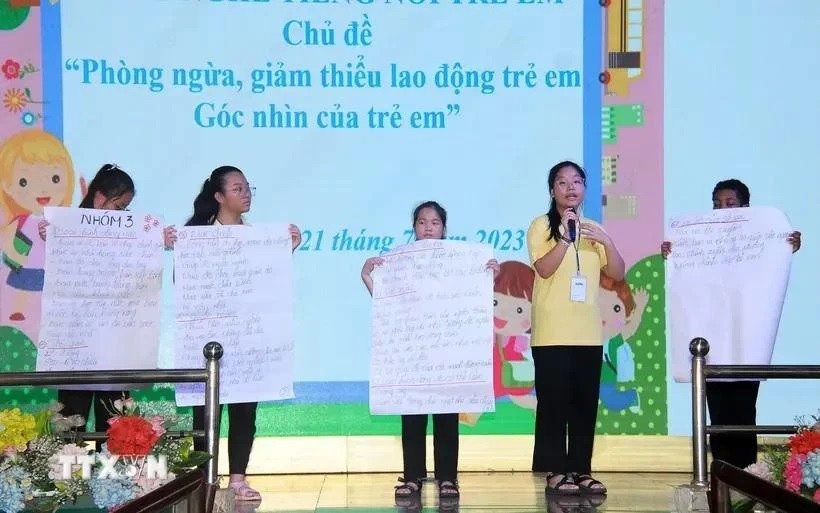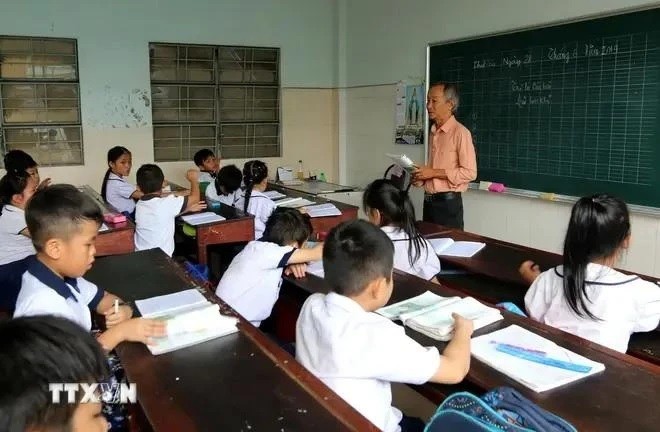
Vietnam seeks to improve livelihoods to end child labour: MOLISA
Latest
 |
| Vietnam seeks to improve livelihoods to end child labour: Children in difficult circumstances participate in a forum to listen to children's voices with the theme "Preventing and minimising child labour" (Photo: VNA) |
A national report on child labour conducted by the Ministry of Labour, Invalids and Social Affairs (MOLISA) in 2020 showed that there were more than 1 million children involved in labour activities, mainly in agriculture, construction and services.
Children forced to work early are concentrated in rural and mountainous areas in the northern, Central Highlands and Mekong Delta regions, where economic conditions are less developed and access to education is limited. According to a report by the United Nations Children's Fund (UNICEF) in Vietnam, the rate of child labour in rural areas is nearly 4 times higher than in urban areas.
Experts said that there are many reasons why children have to work early, with the main reason being poverty. A report by the MOLISA shows that 70% of working children come from poor or near-poor families. The second reason is that some children cannot continue to go to school because they have to help their families make a living. According to UNICEF data, more than 20% of working children do not go to school or have to drop out of school early.
Dang Hoa Nam, Director of the MOLISA Department of Children’s Affairs, assessed that over the past decade, Vietnam has gained remarkable achievements in addressing child labour, establishing a solid legal framework to better suit international standards and implementing a number of programmes to reduce child labour at the central and local levels.
The Government has signed and ratified international conventions on children's rights and child labour combat. These include the International Labour Organisation (ILO)’s Convention on Minimum Age (C138) and Worst Forms of Child Labour Convention (C182). In addition, several national programmes to prevent and reduce child labour for the 2021 – 2025 period, with a vision to 2030 are being implemented to minimise this situation, including support of education and vocational training to improve living conditions for poor families.
Every year, thousands of poor students, students in difficult circumstances, and orphans are given scholarships and tuition support to help them have the opportunity to continue studying. In 2023, the National Fund for Vietnamese Children granted 13,877 scholarships worth 9.4 billion VND (nearly 370,000 USD), and assisted 17,800 children living in difficult circumstances with a total cost of more than 20 billion VND.
 |
| Vietnam seeks to improve livelihoods to end child labour: Children living in difficult circumstances study at Thien An charity school. (Photo: VNA) |
According to experts, international cooperation is one of the most effective measures to help solve the main cause of the increase in child labour: poverty. International projects have focused on supporting the livelihoods of vulnerable families, helping children participate in labour appropriately and safely in accordance with laws.
For example, the Technical Support for Enhancing the National Capacity to Prevent and Reduce Child Labour in Viet Nam (ENHANCE) project, implemented in Hanoi, Ho Chi Minh City and the Mekong Delta province of An Giang since 2015, has brought about positive results.
After more than eight years, nearly 6,000 children have been supported with education and vocational training and nearly 550 children have received non-educational support such as health insurance. Some 1,600 households have received assistance to improve their livelihoods.
Experts assessed that over the past three decades, Vietnam has seen a lot of achievements in poverty reduction. The rate of child labour is 2% lower than the Asia Pacific region’s average. The country's efforts in reducing child labour have been recognised by the international community, including a positive assessment from the ILO.
The country is working to complete the Sustainable Development Goal (SDG) Target 8.7 towards eliminating child labour in all its forms by 2025.

















